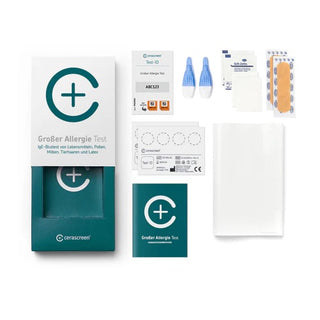-
Product description
Please note that a meaningful result can only be obtained if you have previously (approx. 2 weeks) come into contact with the allergen.
Symptoms of a latex allergy
A latex allergy can manifest itself in two different types of allergic reactions, the immediate type (Type I) and the delayed type (Type IV). In delayed-type allergic reactions, it is primarily the skin that reacts to direct contact. The onset of symptoms takes much longer than is the case with the immediate type. The allergic reaction is directed against the additives in latex production that are present in the end product. Contact eczema develops in the areas that came into contact with the allergens. This manifests itself in the formation of blisters, nodules and reddening. If the allergen is not avoided, the affected skin structure changes. The immediate-type allergy tested here, on the other hand, is aimed directly at the natural latex proteins. Before the allergen enters, the body tries to fight the intruder with the help of immunoglobulins. So he reacts immediately after contact with the latex allergens with typical symptoms depending on the way of contact. In case of skin contact, the skin reacts immediately with wheal formation. These skin symptoms are not limited to the contact area with the allergens and can develop into general symptoms. Possible reactions when inhaling the latex allergens can be:
- Watery and itchy eyes
- itching in nose and eyes
- runny nose
- sneezing fits
- coughing
There is a risk of a general allergic situation developing with circulatory problems or even an allergic emergency situation.
Your personal test results
Click once, know everything: In your online customer area we present you with the evaluation of your cerascreen tests - of course password-protected for maximum security! And in your individual expert report you will find out which substances have a negative effect on your performance and thus limit you in everyday life.
This is how the test works


 1. Blood collection
1. Blood collection
With the help of our test kit, you take a small blood sample from your fingertip and send it to our laboratory free of charge in the enclosed envelope.2. Evaluation
In the laboratory, your blood sample will be examined using an extensive analysis.3. Detailed result report
After a few days, you can view your result report online in your secure "My cerascreen" area.
Laboratory with certified quality management system

cerascreen® GmbH is a subsidiary of DST Diagnostische Systeme & Technologie GmbH, which has been specializing in holistic diagnostics for over 10 years. The cerascreen concept is based on many years of experience in DST human diagnostics and the competence and advice of experienced health experts.
Certifications:
- TÜV Rheinland according to DIN EN ISO 13485
- EC declarations of conformity & round robin test
The test kit consists of:
-
- a multi-page, illustrated manual, which explains step by step the blood collection and the test procedure
- 2 return cards with test ID for registration
- Disinfection wipe, swab, plaster, 2 lancets CE 0344, blood collection tube, transport tube
- name label
- a return bag with which you can send your blood sample back to our laboratory by post free of charge

What is latex and where do we come into contact with it?
Natural latex is obtained from the milky sap of the rubber tree and is found in a wide variety of areas and products due to its elastic and water-repellent properties. For example, balloons, seals of all kinds, hot-water bottles, baby pacifiers, (work) gloves, chewing gum, foamed latex mattresses, rubber boots, water-repellent clothing, tires, condoms and, especially in the medical field, many products made of latex. People from certain professional groups such as doctors, carers and nurses are therefore particularly affected. It is known that intensive skin contact with latex also increases the risk of latex allergy. If you also belong to the risk group or discover one or more symptoms in yourself, you should not hesitate and order our latex allergy test for the home.
Are you also affected? Do the check with our latex allergy test
You can easily and easily test whether you are also affected by a latex allergy at home with our latex allergy test. But which symptoms lead to the assumption that you suffer from a latex allergy? There are two types of allergy, the immediate type and the delayed type. In the case of the latter, the body reacts to certain additives in the production of latex, which trigger delayed reactions in these areas if they come into direct contact with the skin. The result is contact dermatitis in the form of nodules and redness. With the immediate type, the body reacts to a protein contained in natural latex. Immediately after contact, itchy wheals appear on the surface of the skin. Hay fever-like symptoms such as itching, swelling of the skin, eyes and mucous membranes, sneezing fits, coughing, gastrointestinal problems and even shortness of breath can occur as an allergic reaction. If our laboratory detects a latex allergy in you, we advise you to carry an allergy pass, which you should always carry with you and which you should always show when you are in hospital. An emergency kit consisting of anti-allergic drugs, an adrenaline injection and an asthma spray should also be part of the basic equipment. Unfortunately, desensitization does not provide relief from latex allergy and long-term treatment is difficult. The only option for those affected is to consistently avoid any latex products. These can be replaced with synthetic rubber materials instead. However, natural latex can also be found in many plastics without there being any obligation to declare its use.
How to do the latex allergy test yourself
With a latex allergy test from cerascreen, you will already know within a few days whether you are suffering from an immediate-type allergy – without the hassle of going to the doctor. So how do you go about doing this? First you order your sampling kit online. This set consists of detailed instructions on how to carry out the test, lancets for painless blood collection, a blood collection tube, disinfectant wipe, plaster and return bag. Use the lancet to prick your fingertip briefly until a small drop of blood forms. You carefully collect this with the collection tube, close it carefully and send it back to our laboratory free of charge using the enclosed envelope. Our diagnostic laboratory evaluates your blood sample, which can be clearly identified by means of an ID, in a comprehensive analysis and provides you with a comprehensive but easily understandable result report on your diagnosis online. Do you still have questions about your result? Use our service hotline for this - our team of experts will be happy to answer all your questions about allergies and provide you with additional information on the subject of health. cerascreen – your health experts.
Product description
Please note that a meaningful result can only be obtained if you have previously (approx. 2 weeks) come into contact with the allergen.
Symptoms of a latex allergy
A latex allergy can manifest itself in two different types of allergic reactions, the immediate type (Type I) and the delayed type (Type IV). In delayed-type allergic reactions, it is primarily the skin that reacts to direct contact. The onset of symptoms takes much longer than is the case with the immediate type. The allergic reaction is directed against the additives in latex production that are present in the end product. Contact eczema develops in the areas that came into contact with the allergens. This manifests itself in the formation of blisters, nodules and reddening. If the allergen is not avoided, the affected skin structure changes. The immediate-type allergy tested here, on the other hand, is aimed directly at the natural latex proteins. Before the allergen enters, the body tries to fight the intruder with the help of immunoglobulins. So he reacts immediately after contact with the latex allergens with typical symptoms depending on the way of contact. In case of skin contact, the skin reacts immediately with wheal formation. These skin symptoms are not limited to the contact area with the allergens and can develop into general symptoms. Possible reactions when inhaling the latex allergens can be:
- Watery and itchy eyes
- itching in nose and eyes
- runny nose
- sneezing fits
- coughing
There is a risk of a general allergic situation developing with circulatory problems or even an allergic emergency situation.
Your personal test results
Click once, know everything: In your online customer area we present you with the evaluation of your cerascreen tests - of course password-protected for maximum security! And in your individual expert report you will find out which substances have a negative effect on your performance and thus limit you in everyday life.
This is how the test works

|
 |
 |
|
1. Blood collection
With the help of our test kit, you take a small blood sample from your fingertip and send it to our laboratory free of charge in the enclosed envelope. |
2. Evaluation In the laboratory, your blood sample will be examined using an extensive analysis. |
3. Detailed result report After a few days, you can view your result report online in your secure "My cerascreen" area. |
Laboratory with certified quality management system

cerascreen® GmbH is a subsidiary of DST Diagnostische Systeme & Technologie GmbH, which has been specializing in holistic diagnostics for over 10 years. The cerascreen concept is based on many years of experience in DST human diagnostics and the competence and advice of experienced health experts.
Certifications:
- TÜV Rheinland according to DIN EN ISO 13485
- EC declarations of conformity & round robin test
The test kit consists of:
-
- a multi-page, illustrated manual, which explains step by step the blood collection and the test procedure
- 2 return cards with test ID for registration
- Disinfection wipe, swab, plaster, 2 lancets CE 0344, blood collection tube, transport tube
- name label
- a return bag with which you can send your blood sample back to our laboratory by post free of charge

What is latex and where do we come into contact with it?
Natural latex is obtained from the milky sap of the rubber tree and is found in a wide variety of areas and products due to its elastic and water-repellent properties. For example, balloons, seals of all kinds, hot-water bottles, baby pacifiers, (work) gloves, chewing gum, foamed latex mattresses, rubber boots, water-repellent clothing, tires, condoms and, especially in the medical field, many products made of latex. People from certain professional groups such as doctors, carers and nurses are therefore particularly affected. It is known that intensive skin contact with latex also increases the risk of latex allergy. If you also belong to the risk group or discover one or more symptoms in yourself, you should not hesitate and order our latex allergy test for the home.
Are you also affected? Do the check with our latex allergy test
You can easily and easily test whether you are also affected by a latex allergy at home with our latex allergy test. But which symptoms lead to the assumption that you suffer from a latex allergy? There are two types of allergy, the immediate type and the delayed type. In the case of the latter, the body reacts to certain additives in the production of latex, which trigger delayed reactions in these areas if they come into direct contact with the skin. The result is contact dermatitis in the form of nodules and redness. With the immediate type, the body reacts to a protein contained in natural latex. Immediately after contact, itchy wheals appear on the surface of the skin. Hay fever-like symptoms such as itching, swelling of the skin, eyes and mucous membranes, sneezing fits, coughing, gastrointestinal problems and even shortness of breath can occur as an allergic reaction. If our laboratory detects a latex allergy in you, we advise you to carry an allergy pass, which you should always carry with you and which you should always show when you are in hospital. An emergency kit consisting of anti-allergic drugs, an adrenaline injection and an asthma spray should also be part of the basic equipment. Unfortunately, desensitization does not provide relief from latex allergy and long-term treatment is difficult. The only option for those affected is to consistently avoid any latex products. These can be replaced with synthetic rubber materials instead. However, natural latex can also be found in many plastics without there being any obligation to declare its use.
How to do the latex allergy test yourself
With a latex allergy test from cerascreen, you will already know within a few days whether you are suffering from an immediate-type allergy – without the hassle of going to the doctor. So how do you go about doing this? First you order your sampling kit online. This set consists of detailed instructions on how to carry out the test, lancets for painless blood collection, a blood collection tube, disinfectant wipe, plaster and return bag. Use the lancet to prick your fingertip briefly until a small drop of blood forms. You carefully collect this with the collection tube, close it carefully and send it back to our laboratory free of charge using the enclosed envelope. Our diagnostic laboratory evaluates your blood sample, which can be clearly identified by means of an ID, in a comprehensive analysis and provides you with a comprehensive but easily understandable result report on your diagnosis online. Do you still have questions about your result? Use our service hotline for this - our team of experts will be happy to answer all your questions about allergies and provide you with additional information on the subject of health. cerascreen – your health experts.












